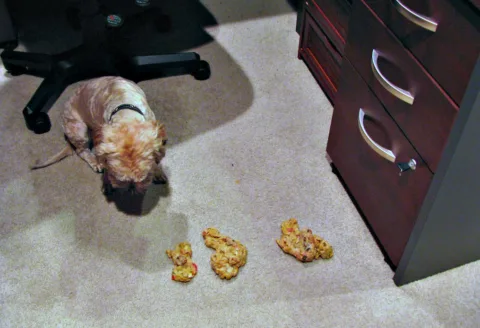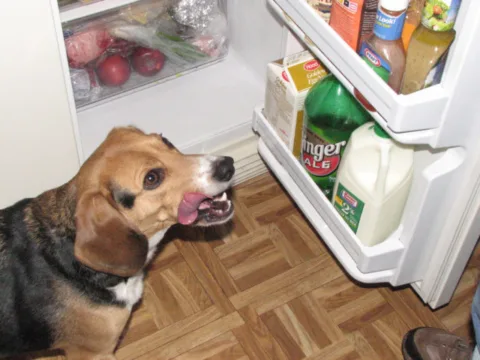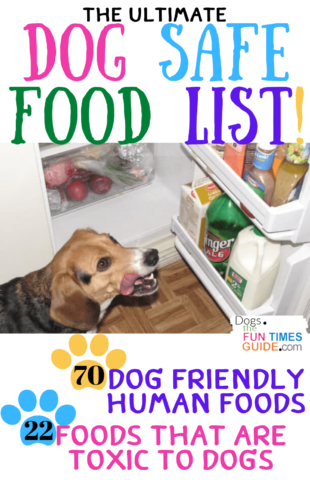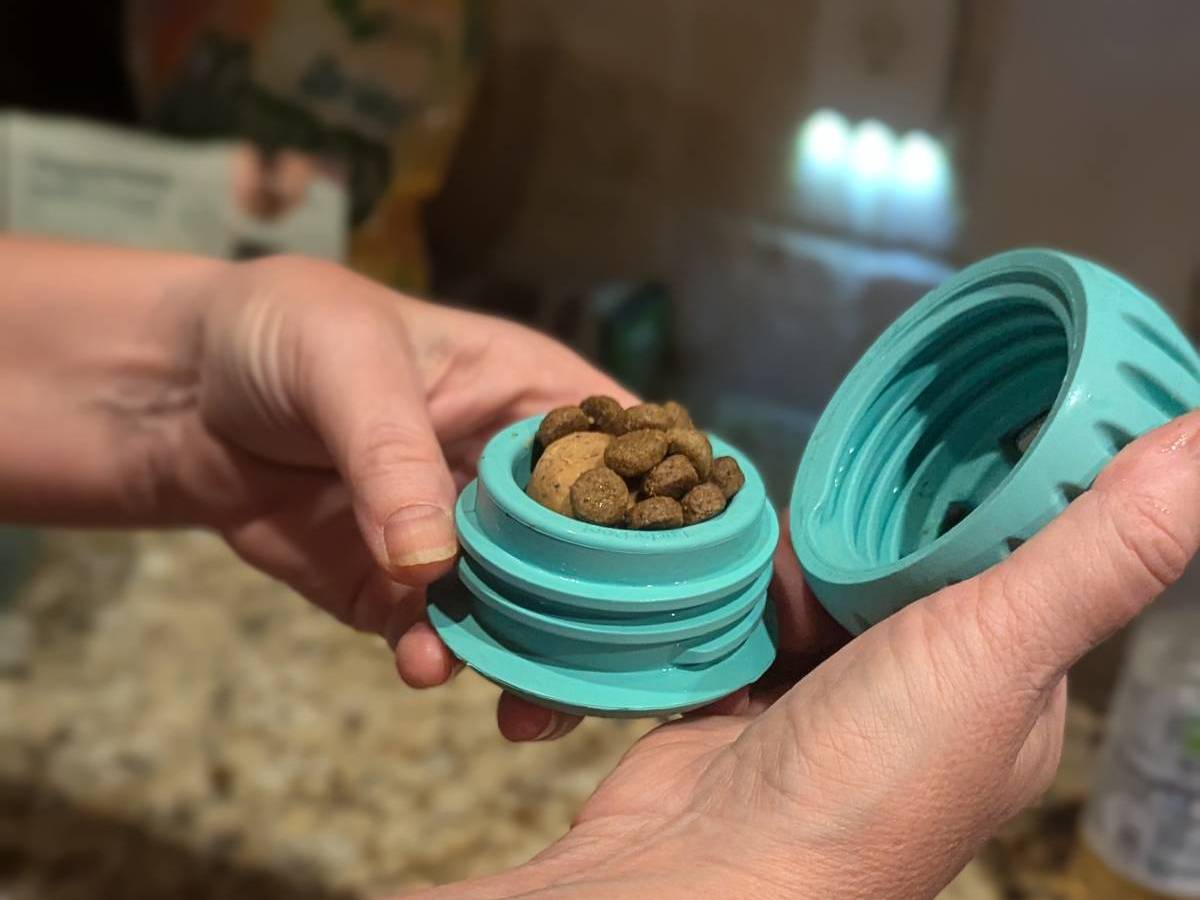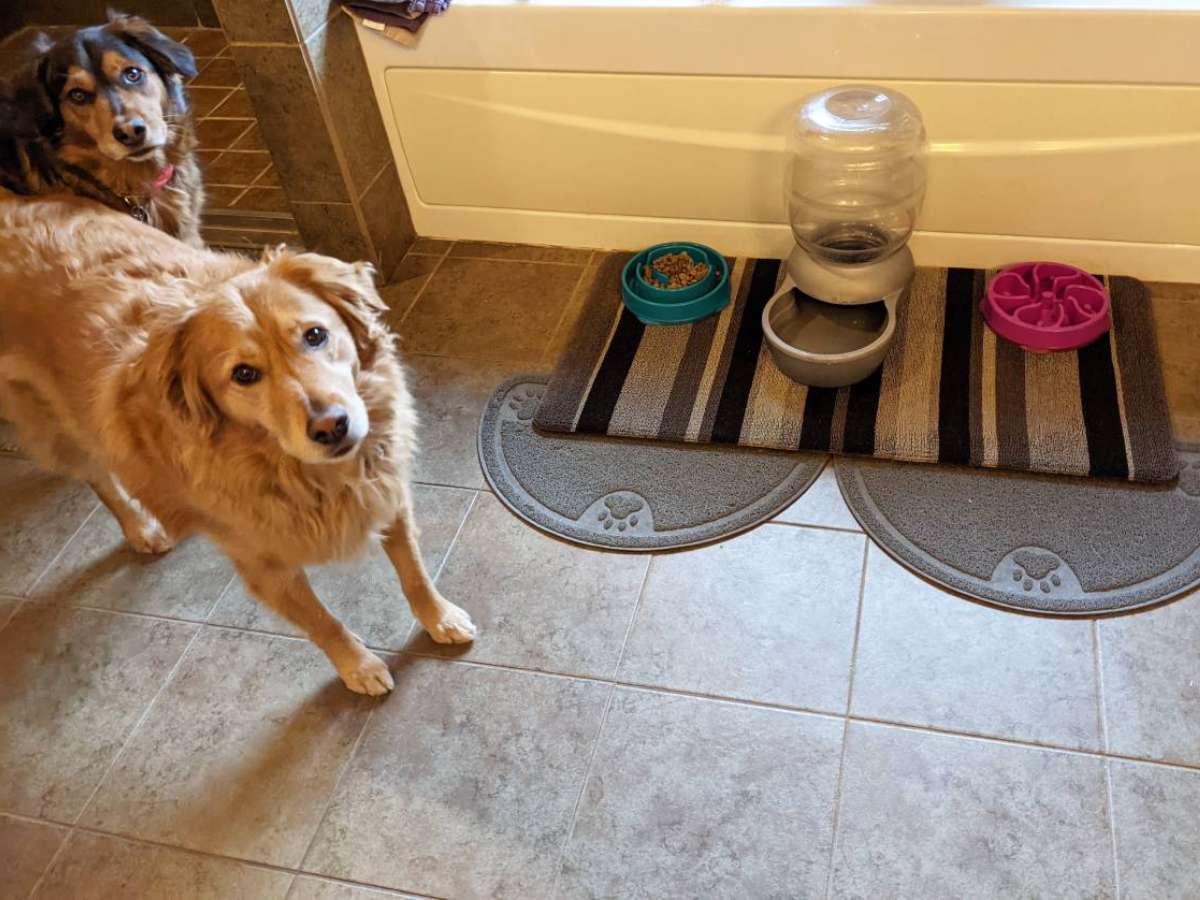Wondering which human foods are safe for dogs and which ones are not?
Here are the foods to AVOID giving to your dog (human foods that are poisonous to dogs), as well as those which are OKAY for pets (human foods that make great dog treats).
Plus, what you should know if you decide to offer table scraps and other people foods to your dog.
Who Gives Dogs Human Foods?!
Some pet owners make a habit of feeding their dogs table scraps. (We don’t.)
But generally speaking, most people stick to serving dog foods to their pets day in and day out.
Of those pet owners who choose to give their dogs human foods, many reserve it for special occasions (holidays like Thanksgiving, Christmas, or maybe your dog’s birthday) or times when you’re nursing a sick pet back to health.
Due in part to the increased popularity of Kong toys, more and more pet owners are also choosing to supplement their dog’s diet with a variety of human foods that are given as “treats”.
Of course, there are some people who are dead set against giving dogs human foods — they think it is completely inappropriate to do so.
While others refrain from giving their pets storebought dog food altogether — choosing instead to only include all-natural human foods in their dog’s diet, or even a raw food diet for dogs.
Whatever your views are on dog diets in general, I think it’s safe to say that your dog will ingest at least one human food at some point in time — either with your knowledge (as a regular diet, or as table scraps or dog treats) or without your knowledge (maybe from the garbage, or given to your pet by someone else).
This begs the question:
Which human foods are safe for dogs to eat?
Furthermore:
What do I need to know if I decide to give my dog foods that were originally intended for people?
After spending my entire adult life raising dogs from puppyhood to senior dogs, these are the most important things I’ve learned about feeding human foods to dogs…
Be Careful What You Feed Your Dog
Not all dogs are alike.
Just because someone else’s dog didn’t have an adverse reaction to a particular human food doesn’t mean that your pet will behave the same way. Your dog could react differently to the taste of the food, or he could even have an allergy to one or more of its ingredients.
You don’t want this to happen to your dog:
Therefore, whenever you are introducing your dog to a new food (or combination of foods, such as those in Kong recipes), be sure to test it out while you are home — so you can monitor your pet’s reaction.
The odds are very small, but there’s always the chance that your dog could be allergic to a particular food, or it just may not sit well with your dog — causing upset stomach, diarrhea or vomiting. Sometimes, even the smallest change in a dog’s diet can cause an adverse reaction.
Also, when introducing people food to your dog, start slow! A dog’s digestive system is different from a human’s and it doesn’t do well with sudden changes — like switching your dog’s diet from standard dog kibble to meals that include some human food. (Here are some tips for determining human food portion sizes for dogs.)
The takeaway: If your dog acts strangely after trying a new food or has known food allergies, then you should consult with a veterinarian — before giving that food to your dog again.
Okay, now onto the specific human foods which are safe for dogs and which ones are not…
Human Foods That Are NOT Safe For Dogs
Following are all of the foods and edible items that are potentially dangerous to dogs (along with links to the sources which cite those items as being harmful and why).
TIP: At the very least, you should avoid feeding your dog human foods that are salty, sweet (high in sugar content), or fatty.
These human foods should not be given to dogs — especially in large amounts:
- Alcohol 1, 2, 3
- Bones (cooked) 1, 2, 3, 4
- Bread dough (raw yeast) 1, 2, 3
- Caffeine 1, 2, 3, 4
- Chocolate 1, 2, 3, 4
- Coffee (grounds, beans, brewed) 1, 2, 3
- Corn cobs 1, 2, 3
- Eggs (raw) 1, 2, 3, 4
- Fat trimmings 1, 2, 3
- Garlic *SEE NOTE BELOW 1, 2, 3
- Grapes 1, 2, 3, 4
- Moldy foods 1, 2, 3, 4
- Mushrooms 1, 2, 3
- Nutmeg 1, 2, 3, 4
- Nuts (especially macadamia nuts) 1, 2, 3, 4
- Onions & onion powder *SEE NOTE BELOW 1, 2, 3
- Pits from peaches, plums, cherries & apricots 1, 2, 3, 4
- Raisins 1, 2, 3
- Rhubarb leaves 1, 2, 3
- Salt 1, 2, 3
- Nicotine products 1, 2, 3, 4, 5, 6
- Xylitol (sugar-free products) 1, 2, 3, 4, 5, 6, 7
IMPORTANT: If you suspect that your dog has eaten something that was bad for him or become poisoned, contact the American Society for the Prevention of Cruelty to Animals (ASPCA) Poison Control Center at 1-888-426-4435. This is a 24-hour a day hotline that operates 7 days a week 365 days a year. (They charge a nominal fee to your credit card for the immediate response and expert advice that could ultimately save your dog’s life.)
Human Foods That ARE Safe For Dogs
The good news: There are many people foods that are safe for dogs to eat. In fact, many of them are quite healthy for dogs! (For items that occasionally appear on lists of foods that are “toxic for dogs,” I’ve included a link to help you decide for yourself.)
TIP: I would encourage you to look at the ingredients that are listed in DIY homemade dog treat recipes as well as homemade Kong stuffing recipes to find some fun combinations of dog-friendly foods that your dog will love.
These are the most popular human foods that pet parents routinely give their dogs — they are safe:
- Apples (no seeds)
- Applesauce
- Apricots (no pits)
- Avocados (no pits, skin, or leaves)
- Baby food (all-natural)
- Bananas
- Beef (scraps)
- Berries (fresh and frozen)
- Bread (not bread dough)
- Bouillon
- Bran cereal
- Bread (without raisins or nuts)
- Broccoli (raw)
- Carrots
- Cashews
- Cauliflower (raw)
- Celery
- Cheerios
- Cheese (American, cheddar, mozzarella)
- Cheese Wiz
- Chicken (cooked, no bones or skin)
- Chicken broth
- Cinnamon
- Coconut
- Corn (not the cob)
- Cottage cheese
- Cranberries
- Cream cheese
- Croutons (plain)
- Eggs (cooked)
- Fish
- Flax seed (ground or oil)
- Ginger
- Green beans (canned, no salt)
- Ham
- Honey
- Ice cubes (frozen cubes of beef broth or chicken broth)
- Ice cream *SEE NOTE BELOW
- Kale
- Lettuce
- Melons
- Milk
- Mint (helps with bad breath)
- Nectarines (no pits)
- Nuts (peanuts, cashews)
- Oatmeal
- Orange slices (no rinds)
- Organ meats (giblets, liver, tongue, heart, gizzards
- Parsley
- Pasta noodles (cooked)
- Peaches
- Peanut butter (creamy or chunky, preferably all-natural)
- Pears
- Peas
- Pineapple (fresh or frozen)
- Popcorn (no salt, toppings or kernels)
- Potatoes (no butter or green parts)
- Pumpkin (canned, not pre-spiced pie mix)
- Quinoa
- Rice (cooked)
- Rice cakes
- Shrimp (cooked)
- Spinach
- Squash
- Sunflower seeds (unsalted)
- Sweet potatoes
- Tomatoes (not the plants/leaves/stems or unripe tomatoes)
- Tuna (and the juice from canned tuna)
- Turkey (cooked, no bones or skin)
- Yogurt (plain, low-fat, unflavored, unsweetened)
- Zucchini
Here’s a good list of plants & herbs that are safe for dogs (including the ones that are not).
And here’s a list of all-natural ingredients that are safe for dogs:
- For fresh breath (helps eliminate dog breath) – mint, parsley, dill
- For repelling fleas, ticks, and worms (insects that gravitate to dogs) – garlic
- For arthritis (joint pain) – alfalfa
- For skin and hair (smooth, shiny coat) – oat, flaxseed
- For nerves and anxiety (calming effect) – oat
- For digestive system (helps alleviate motion sickness) – ginger
- For gas (flatulence) – fennel, thyme, ginger
- For better digestion (also good for the kidneys and urinary tract) – dandelion
- For boosting the immune system (strengthening the body) – green tea, garlic
- For antioxidants (protects the body’s cells) – basil, oregano, thyme, rosemary, green tea
For the foods and ingredients listed above, see why they are good for dogs.
What About Garlic, Onions, And Ice Cream?
I know, I know. Garlic and onions both appear on the “do NOT give your dog” list above. Why? Because the safest option is to error on the side of caution.
HOWEVER… in most cases, it would take a LOT of garlic or onions to make your dog sick!
It is well-known that garlic is a good repellent for fleas, ticks, and mosquitoes.
That’s why it’s included on many lists (not just mine) as “safe” or “safe in small amounts” or “safe when only given for a short time”.
So if you’re dealing with a very bad case of fleas, ticks, or mosquitoes… then you might want to experiment with garlic to see if that helps the situation. (Remember… start small! And if your dog has any known health issues, then definitely check with your vet first.)
This is from the AKC American Kennel Club:
How much garlic is toxic to dogs? Studies have found it takes approximately 15 to 30 grams of garlic per kilograms of body weight to produce harmful changes in a dog’s blood. To put that into perspective, the average clove of supermarket garlic weighs between 3 and 7 grams, so your dog would have to eat a lot to get really sick. However, some dogs are more sensitive to garlic toxicity than others, and consumption of a toxic dose spread out over a few days could also cause problems.
~AKC
And this is from Dogs Naturally:
If you look at any dog-centered poisonous plant list, garlic is there. Don’t fret! You have nothing to fear and everything to gain. I’ll set your mind at ease by telling you how to properly prepare garlic for dogs for maximum health benefits. And how much you can safely feed your dog. Your dog’s digestive system needs to be healthy before you feed her garlic.
~Dogs Naturally
If you still need more clarification about dogs eating garlic, check out this video from a veterinarian:
Another example that you may be personally familiar with is ice cream.
Many of us give our dogs ice cream as a special treat on occasion. Plus, lots of drive-thru restaurants even give free ice cream cups to dogs — and dogs are not dying because of it.
It’s all about moderation. (Too much of anything is rarely a good thing!)
Sure, some dogs don’t tolerate dairy products well. And if that’s your dog… you’ll know. It’s actually the amount of lactose in dairy products that causes a problem.
My best advice is to use your own judgement, consult with a veterinarian whenever you have specific questions, and keep in mind that smaller and weaker (sick or unhealthy) dogs are least likely to be able to tolerate any foods that are questionable.
A Word Of Advice About Trying New Foods
Before you introduce a new food to your dog, there’s one other thing that you should take into consideration: the “begging” factor!
In our household, we’ve noticed that our dogs tend to beg for people foods any time they smell something they’re familiar with. On the other hand, if they’ve never tasted it before, then they don’t beg for it.
For that reason, we have only introduced 2 human food items to our dogs: peanut butter and bread:
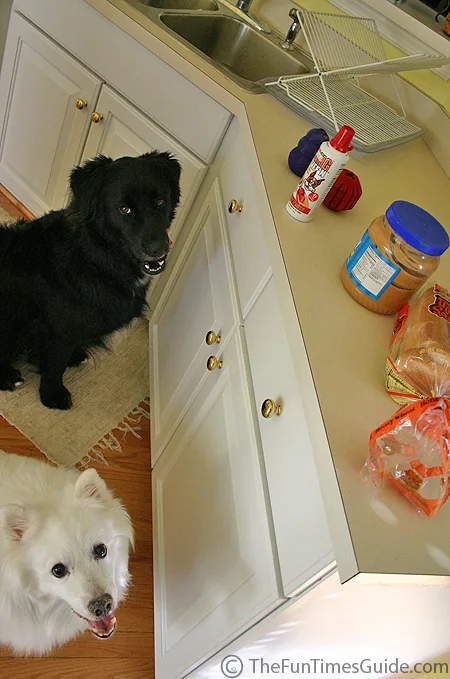

They get those on a fairly regular basis as treats — usually mixed in with regular dog kibble in their Kong toys. When it comes to filling Kongs, we layer ingredients inside the Kong toy using various combinations of those 2 human foods and other store-bought dog foods, treats, and Kong-friendly products made specifically for dogs.
To give you an example, any time we crack open a jar of peanut butter (…wait, I mean move the peanut butter jar from the pantry to the counter!) or open a loaf of bread, our dogs start salivating and licking their lips in anticipation of getting some. Yet we can hold a big ‘ol steak in front of them, and they don’t blink an eye!
So just remember, once you introduce a particular food to your dog, there’s no going back. They’ll always want some of yours whenever you’re eating that food in the future.
We’ve also reserved a handful of other human foods for times when our dogs have various ailments (like diarrhea) or when our dog needs to take pills. Those foods are: rice, cheddar cheese, cottage cheese, and plain yogurt. They make the process of giving pills so much easier. However, yes, our dogs do tend to beg for them now when we’re eating them ourselves. So be careful about which foods you use to associate your dog with a good experience!
On a related note, here’s a list of plants that are not safe for dogs (includes plants that are safe, as well).
Like this post? Save it to read again later… or share with others on Pinterest!


